A complete feeding schedule for 8, 9, and 10 month old babies. Plus tips for transitioning to finger foods for an eating schedule with formula or breastmilk.
Affiliate links used below. See our full disclosure.
Your baby is getting bigger, and they are approaching their first birthday. So… what, when, and how much should they be eating at this point?
What should the feeding schedule for an 8 month old look like? Well, actually, not too much should change from their 6-7 month old schedule, in terms of timing, at least. And, this feeding schedule will continue for 9 and 10 month olds, too.
Hopefully, by the time your baby is 8 months old, you are getting into a bit of a routine and having regularly scheduled meals. However, that doesn’t mean that your baby is necessarily consuming large amounts of either baby food or table foods.
Some babies are still warming up to this eating thing, and breast milk/formula continue to provide the bulk of their nutrition. It’s important not to focus on the volume of solid foods, but to have a positive experience around eating.
For my third son James (11 months), the pureed baby foods were done half way into the 8th month except for everyday pureed foods like yogurt and applesauce and the occasional pouch while we were out.
From that point on, he was completely on table/finger foods. I know that may sound shocking to some of you, because many American parents like the safety net of baby food. While I get that line of thought, as an OT, I strongly encourage you to not rely too heavily on baby food.
It is one of the biggest mistakes I see parents make. Sometimes parents are worried about the risk of choking or don’t like seeing that occasional gag. Other times parents keep offering the baby food because they can really quantify how much finger foods their child has actually eaten.
Although this may seem harmless, in my practice, I have many times seen children end up transitioning poorly to table foods because parents pushed baby foods for too long.
And by the time your baby is 11, 12, and 13 months, things will change. Read more on our 11-month-old and toddler feeding schedule
Having said that, there certainly are times when babies are having difficulty transitioning to table foods despite their parent’s best efforts.
If you need help with this process, I highly recommend checking out our free 1 hour workshop about what to do (and what not to do) when feeding your baby finger and table foods.
The schedule that you find below is created with the assumption that your child is transitioning well. If they are not quite at this point, you will want to see the 6-7 Month Feeding Schedule for the foods I suggest for that age, but the timing of meals listed here will still be appropriate.
8, 9, &10 MONTH OLD FEEDING SCHEDULE
The sample schedule you see here may look a little different for you, that’s okay, but you want to see some similarities and patterns similar to this one because this sets the stage for that easy transition to eating meals with the family.
Don’t get too focused on specific amounts of times, the intervals are what’s important. You’ll find more of my best tips for nailing a feeding schedule for your 8 (or 9 or 10) month old below the actual schedule
6:30-7:00 AM: Wake-Up – Breastfed/Bottle upon waking
7:00-7:30 AM: Breakfast – Water available in a straw cup**, table foods (include a fruit/veggie, carbohydrate, and protein), and optional side of baby food
9:30 AM: Nap
11:00 AM: Breastfed/Bottle upon waking
11:30-12:00 PM: Lunch – Water in a straw cup, table foods (include a fruit/veggie, carbohydrate, and protein), and optional side of baby food
1:30-2:00 PM: Nap
3:30 PM: Breastfed/Bottle upon waking, immediately followed by an optional small snack such as fruit and crackers/dry cereal/rice cake. (If your child takes a longer nap, there will likely not be time for this, this snack time will probably only happen occasionally.)
6:00 PM: Dinner – Water in a straw cup, table foods (include a fruit/veggie, carbohydrate, and protein), and optional side of baby food
7:30- PM: Breastfed/Bottle before bed
7:45-8:00 PM: Sleeping for the night
*Times are given in a range of possible start times, not duration. Also, note that by the end of this age range, your child will mostly, or totally, be eating table foods and solid food meals.
In most instances, they will still not need baby food any longer by their 10th month. If you are concerned about how much your baby needs to eat, see this post on what Portion Sizes your kiddo needs.
**Babies are capable of being taught how to drink from a straw cup at 9 months of age, sometimes earlier. Start giving your baby opportunities to drink out of one at least once a day while they are learning.
If you aren’t sure what straw to use, go with a thinner straw so they don’t get too much liquid at one time. I love the Munchkin Weighted Straw for the older baby crowd!
Feeding Your 8 – 10 Month Old
Your baby may start to show some preferences for certain types of food, that is normal. Although, you’ll want your child to eat something, you also have to be careful to balance not over catering to them either.
Make sure you have one preferred food at each meal and continue to offer new ones. It can take many times and many different presentations for a child to try something. Don’t let this discourage you.
There will be meals, even at 10 months old, where your baby just has a few bites of food. That is okay, and it can happen for a variety of reasons.
If you’re nervous at all about this transition I highly recommend grabbing our free guide for How to Teach Your Baby to Eat Table Foods!
What to Feed Your 8 – 10 Month Old
If it’s possible, start to get in the habit of feeding your baby what you’re eating! Or plan meals ahead of time so that they can eat some of what you’re eating.
If you need some inspiration, we have some helpful lists of food ideas and recipes that are perfect for babies that are new to table and finger foods:
- The Best 9 Month Old Baby Food + Table Food Ideas
- Mega List of Table Food Ideas for Babies
- Easy Meals Ideas for Babies and Toddlers
- High Calorie Foods for Babies.
While you feed your baby, try to eat at the same time. Eating together is so valuable for your baby learning to chew, explore foods, and that eating is fun. Your baby needs to have a sense of a meal being an event, not something that has to get squeezed in.
And as they eat, don’t forget to let your baby get messy while eating, especially when they feed themselves, which should be as much as possible. Most babies will still need a lot of help using a spoon by the end of 10 months old, but let them try.
I start giving a fork with rounded prongs and pierce the food for them. They should be mostly finger feeding, but self feeding is a good habit and skill to promote.
One last thing…
Start thinking about weaning. Babies may start taking less milk in this period if they begin to eat more at meals. Follow their lead. However, you should continue to use formula or breast milk until their first birthday, according to the American Academy of Pediatrics.
If you want to have an idea of what steps to take, check out How to Wean from the Bottle and How to Wean from the Breast.
What if Baby Won’t Eat?
If you feel like your baby won’t eat, isn’t getting the hang of table foods or is consistently eating very small amounts of food or ignoring all attempts at new foods at 10 months of age, then I would strongly suggest scheduling an evaluation through early intervention (if you live in the states) or seeking out a private or outpatient therapist.
Unfortunately, many times pediatricians advise to wait it out, but trained feeding therapists (usually OT’s and SLP’s) are able to catch early signs of underlying sensory or motor difficulties. The earlier these problems are addressed, the easier they are to overcome.
Talk to your child’s doctor and seek out feeding therapy, if you have concerns about how your child is eating.
If you want help now, check out our online course, Table Food School, where I teach you how to use feeding therapy strategies to help your child learn to eat, when they are gagging or refusing to eat!
More about Feeding 8, 9, and 10 Month Olds
What You Need to Know About Baby Gagging
The Ultimate Guide to Feeding Milestones for Babies and Toddlers
When Can Babies Eat Puffs, Cheerios, and Other Foods Safely?
8 Feeding Red Flags for Babies and Toddlers
Alisha Grogan is a licensed occupational therapist and founder of Your Kid’s Table. She has over 19 years experience with expertise in sensory processing and feeding development in babies, toddlers, and children. Alisha also has 3 boys of her own at home. Learn more about her here.
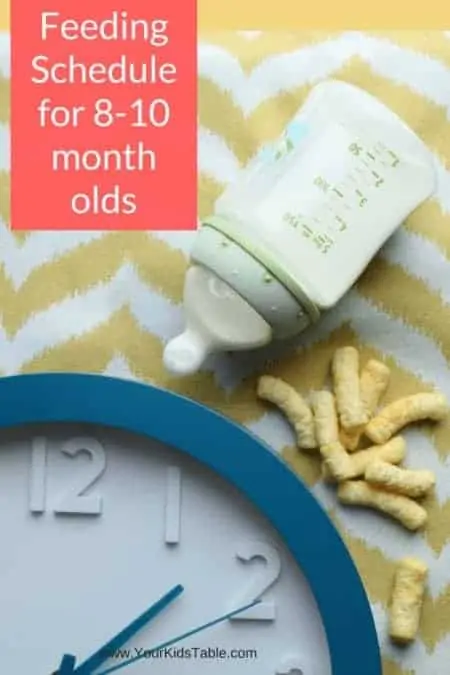
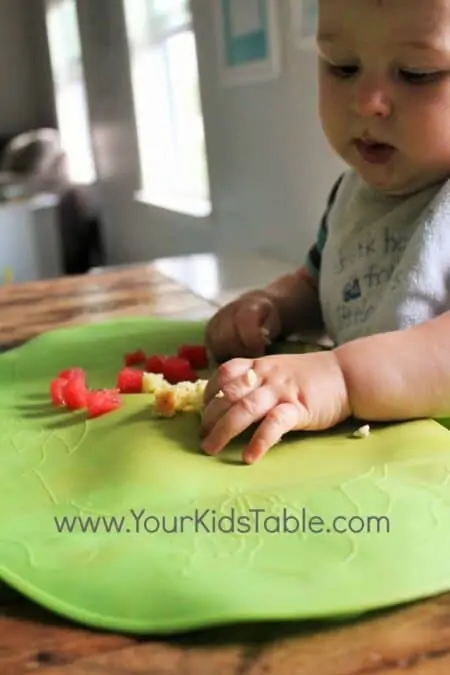
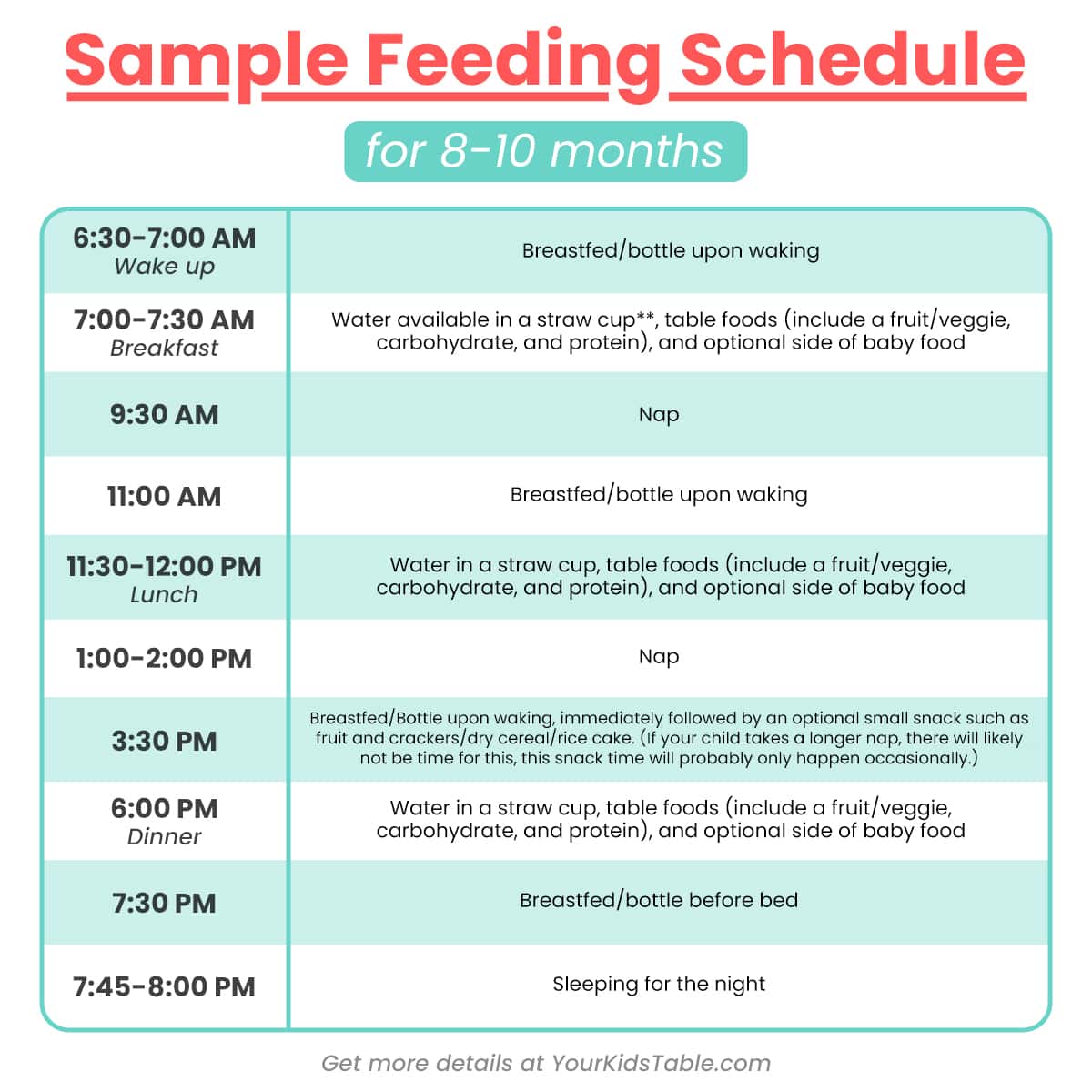
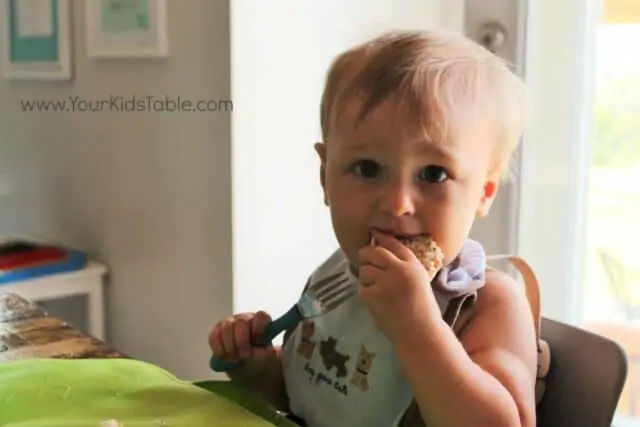

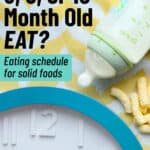

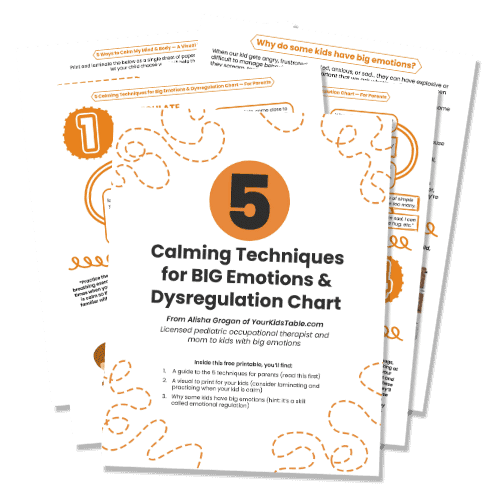
Love your articles! Used them for my first born easily, but second is more tricky. I find after a bottle in the AM (around 645)she is not particularly hungry for solids by 730am (10m old) but then is starving for a bottle before nap at 930. What would you suggest?
Thanks Stacey! There is definitely room for flexibility here. I’d push solids to 8:30 or even 9 and then follow with a bottle. That meal might be smaller, but eventually in a couple months she will likely start decreasing milk so you can encourage the solids to slowly build up at the same time. Let me know how it goes!
Best,
Laura
Your Kid’s Table team member
Hi Alisa,
Thanks for this useful and wonderful article. My daughter is 10 months old now.We introduced her solid foods when she was 6 months old.Initially she was doing great with the solids. For the past few weeks she is ignoring to eat the solids. Initially we boiled the vegetables mashed and gave her. Now we are cutting into pieces the boiled vegetables in order to make her feel the texture. She is playing,getting messy but still I feel she is not eating properly. Also she had cold and fever like 3 times within this 1 and a half month.I would like to know because of this baby’s appetite will change and lost interest in solid foods?
Please let me know.
Thanks in advance!!
Hey Danven,
So happy you found our article useful 🙂 Anytime there is a cold or multiple colds appetites can change. It may take awhile to get settled back onto the foods that you were. I’d try not to change them too much from what she was eating prior to being sick then after she is accepting again, start working your way back up! Hope everyone stays healthy!
Best,
Desiree
I’m glad you wrote this my daughter is 10 months and she drinks formula and was doing great with baby food. All of a sudden she just started turning away from baby foods maybe take a bite or 3 and doesn’t want any more. I’ve tried for days but she only will drink her milk (formula) and take a few bites. She will stick her hand in my plate and I try to let her try certain foods but I know some she cannot eat(chew/gum down). She will hold in her hand play with and drop it others I put in her mouth. At this time she does have 6 teeth 4 at the bottom 2 at the top. I am freaking out because at this point it’s going in a week so I dont know weather to give her more table foods and less baby foods or maybe try the teething gel but I will try both options. Any other suggestions?
Hello!!
Thanks for reaching out! We understand how much of a challenge this time can be switching from purees to regular food! I’d recommend trying to let her have control over the baby food with providing spoon, and letting her dive in with her hands to get messy with it as well! I do think you’d get some great tips and what foods to try next with your daughter in our free workshop! You can save your seat here
Best,
Desiree
My almost 10mo was eating a much wider variety of foods. But I think teething has created some very specific preferences. He will no longer eat peaches, fresh berries, banana, cheese when he is home with me. The two days when he is at day care he eats everything! He has never eaten bread or much meat (except braunschweiger) for me, but will eat hamburger, turkey, beans, you name it at day care. Right now he mostly wants puffs, freeze dried strawberries, pressed fruit bars, seaweed snacks, pickles. He will touch some foods like banana, fresh berries, meatball, cheese… and immediately drop it back onto table or floor. If it makes it to his mouth he spits it out. He won’t let me feed him, so I don’t even know if he will eat yogurt or chia pudding at this point.
At what point do I get concerned? Just keep offering foods and maybe he will widen his palate again?
I am so glad that you reached out!! I can definitely understand that this is a tricky time. I would recommend following through on the Tips for successful meals listed in the article, as well as looking at the sample feeding schedule. Sticking to a schedule and being consistent on what you are offering can help tremendously. Also, you can reach out to daycare to discuss their schedule to see if you can replicate at home. I’d recommend reading this article to understand all options for feeding therapy if you become interested!! https://yourkidstable.com/feeding-therapy/
Hi,
My LO was 10 months old. Refusing to drink formula after introducing solid food for a month. She is just drinking like 300ML of formula and I don’t think it is enough nutritious for her. What should I do. Switch formula? Change teet ? Really stress.
Hey Lana,
If she’s not getting enough formula and still under the age of 1, I’d reach out to your pediatrician, so that you can get onto a plan for making sure she obtains all her dietary needs!
Best,
Desiree
Please help me. I have 10 months old baby. Until now I was pumping and he was bottle feed with my milk.
07:00 am 180ml breast milk
10:00 am cereals +formula +fruit
02:00 pm lunch meat&veggies
05:00 pm 200ml breast milk
08:00 pm cereals + formula
The problem is that I have to stop pumping because I have some health problems and baby doesnt want drink formula (eats only with baby cereals flakes). With what food should I repleace this two breast milk meals?
Thank you
I’d definitely check with your doctor on this, but I’d also keep trying and if you have anyone else that can give your baby a bottle, I’d have them try too, a lot. And, if you have any frozen milk, use that to dilute the formula to help them get used to the taste.
Thank you for youŕ time to answer. I was mixing my milk with formula and it went well. I dont have any breast milk anymore but I will contact my pediatrician about that and see what can I do.
How much formula is recommended for a 9 month old at each bottle feeding? My son nurses in the morning, mid day and at bedtime. He takes a bottle with 8 oz. of breastmilk twice a day (midmorning and late afternoon). I am not producing as much and can no longer pump for those 2 bottle feedings. I am looking for advice on formula feeding and introducing (more) solids/meals/snacks.
These posts on transitioning to table foods might be helpful, and 16-24 ounces per day is the general guideline, but I’d check with your doctor.
Do you have any high chair recommendations?
I personally love the Tripp Trapp, it’s an investment though. You can read more in this post.
Thank you for your posts and info! Why do you prefer a Straw Cup over a 360 Spoutless sippy/trainer cup. We are 8.5 months old and still on Breast Milk – do puree foods regularly since 6 mo old and now working hard on trying to transitioning to table food for some meals. Thank you!
An open cup, like the trainer, is a great skill too! I love the straw, which I don’t recommend until 9-10 months old, works on different muscles, and is also good for development.
Hi
My baby appears to have some digestive issue when she first goes to sleep at night.
When I put her down at night after last milk feed, she has been waking up numerous times and more recently she’s sometimes sick. Often she does a big burp.
The wakings can go on for a couple of hours
It took us a while to work out why she was waking and had to rule out teething etc first, but we realised what it was as its got worse and escalated to her sometimes being sick.
Now I’m not sure how to correct the problem, is she overeating dinner or she drinking too much last milk feed? My mother suggested going back to purees as the sick has chunks of undigested food in it.
Im not keen though as she’s really taken to self feeding from word go and we only did purees occasionally. She’s 9 months, has 7 teeth and seems to chew and handle food well and she absolutely loves it. We have a good routine, regular breast feeds (she’s exclusively breast fed) and I think a reasonable gap between dinner and bed, dinner 5pm bedtime feed around 7.
I am giving her less pudding (it’s usually just fruit), burping her, giving her a 3pm snack so shes not so hungry at 5pm dinner, elevated cot, keeping her upright after last feed, it’s better but shes still seems to be uncomfortable.
My boobs are more full of milk as she’s not drinking so much in day or night any more as she has a good intake of food so I’m wondering if she’s getting too much foremilk on last feed? . She doesn’t have the problem any other time of day or with her two naps.
Any advice appreciated.
Hey Amy,
Sounds like you are doing a great job with attempting to change some things around. I would try to space out her last feed and bedtime a little more so that you do have more time in between so have her stay upright and work on that digestion. I’d also make sure to mention this to the pediatrician as well. Hope that helps!
Best,
Desiree
Great news, my almost 9 month old baby loves food! But how much milk should he be drinking at this point? It can be a struggle to get him to drink much due to a combination of teething, desire to be independent (who knew it started this young?!) and lack of interest. He is exclusively bottle felt with (mostly) expressed milk.
That is great! I’d definitely check with your doctor. At 12 months, it’s around 16 oz, but at your son’s age, it could be up to 24 oz.
Hi my doughter 8th month old and she getup after 9 am so when should I give solid to her and how
The schedules listed here are just examples. You just need to adjust them to fit for what works for you and your child.
What do yo recommend as good first foods for an eigth month old? WHat about sizes or how to offer it?
Check out this post on How to Transition your Baby to Table Foods. I think it will really help!
My baby girl is 8 month old.still refuse to baby food.Just want breastmilk.thats why we are doing blw from last 2 weeks .but she is just playing with them..
Hey Thanks for reaching out!
It is great that she is at least touching the food, as touching is the first step to eating. I’d keep providing opportunities for her to continue touching of foods. We do have a free workshop that can help with tips and strategies for transitioning to table foods. You can save your seat HERE
Best,
Desiree
Hi I have a problem with my baby’s weight she’s four months and she weigh 5kg when she was born she weighed 3.25 so very worried she looks like a new born baby what can I do I want her to be very fat
I have a post on High Calorie Baby Food that might be helpful.
You can add cereal to the bottles and start feeding your baby baby foods oatmeal,vegetables fruit also